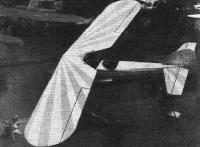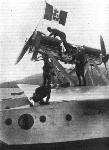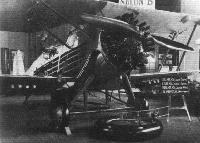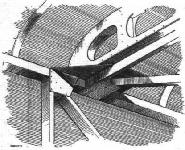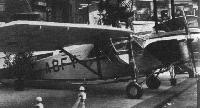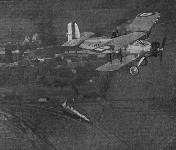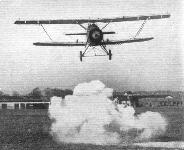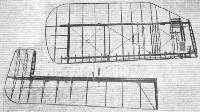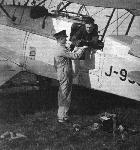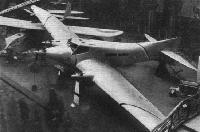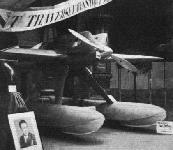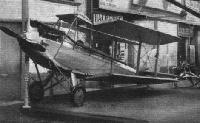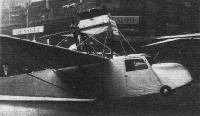Фотографии
-
The Morane-Saulnier 230 is an advanced training machine. Behind it may be seen the Breguet "Question Mark."
Самолёты на фотографии: Breguet Br.19GR Grand Raid / Br.19TF Super Bidon - Франция - 1925Morane-Saulnier MS.230 - Франция - 1929
-
Don Bradman arriving by air at Essendon Aerodrome, Melbourne. The D.H.9 is the Australian Aero Club's advanced training machine, and the Moths are privately owned.
Самолёты на фотографии: De Havilland D.H.9 - Великобритания - 1917De Havilland Gipsy Moth / Moth X - Великобритания - 1928
-
THE ITALIAN SQUADRON'S ATLANTIC FLIGHT: As reported below the twelve Italian Savoia S.55 flying-boats left Orbetello, under the leadership of Gen. Balbo, on December 17. The above picture shows one of the flying-boats being "tractored" to the water.
Самолёты на фотографии: Savoia-Marchetti / SIAI S.55 - Италия - 1924
-
THE ITALIAN SQUADRON'S ATLANTIC FLIGHT: A final inspection being made before the start of the two Fiat A22R engines in one of the boats.
Самолёты на фотографии: Savoia-Marchetti / SIAI S.55 - Италия - 1924
-
The Bristol "Bulldog" is exhibited with panels removed to show the structure and equipment.
Самолёты на фотографии: Bristol Bulldog - Великобритания - 1927
-
AN ALL-METAL "CHARLEY'S AUNT": Our picture shows the first Junkers all-metal monoplane, "D-1," placed on service by Luft Hansa in 1919 - and still, apparently, going strong, as the photograph was taken during a recent visit to Tempelhof aerodrome.
Самолёты на фотографии: Junkers F 13 - Германия - 1919
-
AFTER LILIENTHAL: A motor-assisted glider which has enabled Herr Hans Richter to make short hops into the air at Templehof Aerodrome, Berlin.
Самолёты на фотографии: Lilienthal Glider - Германия - 1891
-
The S.E.C.M. Amiot type 140M is a multi-seater fighter and reconnaissance machine. The engines are neatly cowled in and faired into the wing.
Самолёты на фотографии: Amiot Amiot 140 / Amiot 143BN5 - Франция - 1931
-
AS SEEN FROM THE "Do.X": The "snap" taken by Col. The Master of Sempill: two "Southamptons" moored off Calshot
Самолёты на фотографии: Dornier Do.X - Германия - 1929Supermarine Southampton / Solent - Великобритания - 1925
-
AS SEEN FROM THE "Do.X": The "snap" taken by Col. The Master of Sempill: passing the Channel Islands.
Самолёты на фотографии: Dornier Do.X - Германия - 1929
-
The Armstrong Whitworth Atlas. Under it an Argosy wheel and a model of Argosy.
Самолёты на фотографии: Armstrong Whitworth Argosy - Великобритания - 1926Armstrong Whitworth Atlas / Ajax - Великобритания - 1925
-
Регистрационный номер: G-ABEG The Westland "Wessex" six-seater cabin monoplane, fitted with three Armstrong Siddeley "Genet Major" engines, which has just completed a 6,000 miles tour of the British Isles.
Самолёты на фотографии: Westland Wessex / Westland IV - Великобритания - 1929
-
Регистрационный номер: G-ABDO [3] SIDE BY SIDE SEATING: The latest "Redwing" produced by the Robinson Aircraft Co. is similar in general construction to the first machine, but the engine is an Armstrong-Siddeley "Genet" for which a very neat cowling has been designed. An undercarriage of long stroke is provided so that landings are particularly smooth.
Самолёты на фотографии: Robinson Redwing - США - 1930
-
Регистрационный номер: G-ABDO [3] THE ROBINSON "REDWING MARK II": Three-quarter rear view.
Самолёты на фотографии: Robinson Redwing - США - 1930
-
THE ROBINSON "REDWING MARK II": On the left a view of the undercarriage and the neat cowling of the "Genet" engine. On the right a photograph, taken while the machine was in course of construction, showing the undercarriage, with compression rubbers. Portion of the engine mounting is also visible.
Самолёты на фотографии: Robinson Redwing - США - 1930
-
Регистрационный номер: G-ABDO [3] THE ROBINSON "REDWING MARK II": The telescopic legs of the undercarriage run to the top longerons.
Самолёты на фотографии: Robinson Redwing - США - 1930
-
Details of the fuselage construction. The covering is plywood, except the bottom, which is fabric.
Самолёты на фотографии: Robinson Redwing - США - 1930
-
The bent axles of the undercarriage are hinged to the cross-tubes in the bottom of the fuselage. The brackets on each side of the hinge carry the engine control rods.
Самолёты на фотографии: Robinson Redwing - США - 1930
-
The wing-folding device. T-cranks are mounted on the roots of the lower planes, with cables to the ailerons and links to the pilot's controls.
Самолёты на фотографии: Robinson Redwing - США - 1930
-
On the left a sketch showing rib construction, and on the right the neat end of an interplane strut.
Самолёты на фотографии: Robinson Redwing - США - 1930
-
Pedals are used instead of foot bars for the rudder control. The pedals can be adjusted for length.
Самолёты на фотографии: Robinson Redwing - США - 1930
-
The Boulton and Paul Townend exhaust ring is here shown around a Jupiter engine; some cowling panels behind the ring are removed, showing access to engine.
Самолёты на фотографии: Boulton Paul Sidestrand / P.29 - Великобритания - 1926
-
The Polish Fighter. Type P.VI. Note the formation of the wings.
Самолёты на фотографии: PZL P.7 / P.6 / P.8 - Польша - 1930
-
The Breguet 270 A.2 has a tail boom in the form of a large box-section steel spar to give a better field of fire for the gunner.
Самолёты на фотографии: Breguet Br.270 / Br.330 - Франция - 1929
-
Регистрационный номер: G-ABFY The Puss Moth is a centre of attraction on the Morane-Saulnier stand.
Самолёты на фотографии: De Havilland Puss Moth / D.H.80 - Великобритания - 1929
-
Two inside views of the latest D.H. Puss Moth (Gipsy III) showing the cabin arranged for dual control (right), and as a three-seater (left). The excellent upholstery should be noticed.
Самолёты на фотографии: De Havilland Puss Moth / D.H.80 - Великобритания - 1929
-
The Wibault 3-engined monoplane is characterised by a perfectly straight back. This is probably to avoid panel beating.
Самолёты на фотографии: Wibault Wibault 280 - Франция - 1930
-
Регистрационный номер: J9951, J9956 [2] No. 2 (A.C.) Squadron. A flight practising formation flying with the air gunners ready for action.
Самолёты на фотографии: Armstrong Whitworth Atlas / Ajax - Великобритания - 1925
-
Регистрационный номер: J9956 [2] An Atlas of No. 2 (A.C.) Squadron photographing a railway junction.
Самолёты на фотографии: Armstrong Whitworth Atlas / Ajax - Великобритания - 1925
-
An Atlas of No. 2 (A.C.) Squadron bombing a ground target.
Самолёты на фотографии: Armstrong Whitworth Atlas / Ajax - Великобритания - 1925
-
Two views showing a left-hand lower wing of an Atlas (above), and an aileron, both being good examples of the Armstrong-Whitworth steel construction.
Самолёты на фотографии: Armstrong Whitworth Atlas / Ajax - Великобритания - 1925
-
Preparing for vertical photography. The camera is inserted under the wireless panel, seen on the ground.
Самолёты на фотографии: Armstrong Whitworth Atlas / Ajax - Великобритания - 1925
-
EVACUATION OF INHABITANTS OF KABUL: This picture is a reproduction of a painting by Mr. Johns, representing Vickers "Victoria" Troop Carriers with Napier engines flying over the Kabul-Peshawar area. A reproduction in colour of this painting has been issued jointly by Vickers (Aviation), Ltd., and D. Napier & Son. Ltd., and we are asked to state that on application to Vickers from any of the officers and personnel of the R.A.F., &c, who took part in the Kabul operations, a copy of the reproduction will be sent, post free.
Самолёты на фотографии: Vickers Victoria - Великобритания - 1922
-
On the Boulton and Paul stand. The skeleton wing is for a Blackburn Bluebird. The models in the foreground are for wind-tunnel research on the Townend ring, which may be seen in the background fitted to a Jupiter engine.
Самолёты на фотографии: Blackburn Bluebird / L.1 - Великобритания - 1924
-
The Couzinet type 20, has three Salmson 40-h.p. engines and a retractable undercarriage. Note the very pointed engine cowlings.
Самолёты на фотографии: Couzinet Couzinet 30 / 33 - Франция - 1931
-
Another view of the Couzinet monoplane (right). Note the retracted undercarriage. On the left the Mureaux type III R.2.
Самолёты на фотографии: ANF Mureaux Mureaux 3 - Франция - 1927Couzinet Couzinet 30 / 33 - Франция - 1931
-
ONE OF FOUR FARMANS EXHIBITED: The F.190 which flew to Indo-China in record time.
Самолёты на фотографии: Farman F.190 / F.390 - Франция - 1928
-
ONE OF FOUR FARMANS EXHIBITED: The machine is the F.231 low-wing light monoplane
Самолёты на фотографии: Farman F.230 / F.350 - Франция - 1930
-
The Schreck F.B.A. 310 is a neat little amphibian flying boat carrying pilot and two passengers.
Самолёты на фотографии: FBA Type 310 - Франция - 1930
-
Регистрационный номер: S1575 A SERVICE AMPHIBIAN: Four views of the Saro "Cutty Sark" amphibian flying boat (two D.H. "Gipsy II" engines), which has been supplied to the Royal Air Force for specialised training in navigational instruction, as well as permitting additional experience of the amphibian flying boat. It is a standard "Cutty Sark," very fully equipped with instruments and electrical gear, and is arranged as a three-seater machine with full dual control.
Самолёты на фотографии: Saunders-Roe Cutty Sark / A.17 - Великобритания - 1929
-
The Fokker F.IX 20-passenger machine is fitted with three Gnome-Rhone "Jupiters."
Самолёты на фотографии: Fokker F.IX / F.XII / F.XVIII - Нидерланды - 1929
-
A general view in the Grand Palais, looking north. In the foreground may be seen the wings of the Fokker F. IX and the Caudron three-engined monoplane.
Самолёты на фотографии: Caudron C.180 - Франция - 1930Fokker F.IX / F.XII / F.XVIII - Нидерланды - 1929
-
The Bernard H.V.42 is a high-speed seaplane of Schneider Trophy type.
Самолёты на фотографии: Bernard HV-40 - HV-45 - Франция - 1929
-
A scale model of the Heinkel amphibian monoplane flying boat.
Самолёты на фотографии: Heinkel HE.57 - Германия - 1929
-
The Latecoere 350 is a three-engined commercial monoplane. Note that short lower wings run from fuselage to outboard engine mountings.
Самолёты на фотографии: Latecoere Late 350 - Франция - 1931
-
Of the Liore and Olivier LeO H.27, the all-metal hull only is shown. In front of it is the small two-seater amphibian type LeO H.22.
Самолёты на фотографии: Liore et Olivier LeO H.18 / H.22 / H.23 - Франция - 1928Liore et Olivier LeO H.24 / H.27 - Франция - 1929
-
The twin-fuselage Bleriot 125
Самолёты на фотографии: Bleriot Bleriot-125 - Франция - 1931
-
The Bleriot 125 is a twin-fuselage 12-seater monoplane with two watercooled engines in tandem. The pilot's cabin is between the engines.
Самолёты на фотографии: Bleriot Bleriot-125 - Франция - 1931
-
The "Lascowl" is the Anec III re-designed as an 11-seater, fitted with a geared "Jaguar S" engine.
Самолёты на фотографии: ANEC III - Великобритания - 1926
-
Hanworth Club now provides an alternative to flying, so that their members may use the aerodrome in spite of the fog!
Самолёты на фотографии: De Havilland Gipsy Moth / Moth X - Великобритания - 1928
-
ON "DOUGHNUTS": The above 1931 model Moth is fitted with Dunlop medium low-pressure tyres, and not the Goodyear low-pressure tyre and hub combination, as we were misinformed last week. Dunlop tyres and wheels are, of course, fitted as standard on all Moths.
Самолёты на фотографии: De Havilland Gipsy Moth / Moth X - Великобритания - 1928
-
A Morane-Saulnier built Gipsy-Moth.
Самолёты на фотографии: De Havilland Gipsy Moth / Moth X - Великобритания - 1928
-
Регистрационный номер: F-AIYO ONE OF FOUR FARMANS EXHIBITED: The machine is the F.200, a light monoplane.
Самолёты на фотографии: Farman F.200 - Франция - 1929
-
The Dornier Do.S has the pilots' cockpit raised above the deck level like the bridge of a ship.
Самолёты на фотографии: Dornier Do.S - Германия - 1928
-
The Caudron three-engined commercial monoplane is fitted with three Lorraine radial air-cooled engines. Under its wings may be seen the Caudron low-wing monoplane, type C.195.
Самолёты на фотографии: Caudron C.180 - Франция - 1930Caudron C.190 - Франция - 1929
-
HOME CONSTRUCTION: A view of the Dickson glider built by the Aircraft Club, Harrogate, from "Flight" drawings
Самолёты на фотографии: Lippisch / RRG Zogling - Германия - 1926
-
The Oxford and County Gliding Club at work on their all-metal glider fuselage.
Самолёты на фотографии: Lippisch / RRG Zogling - Германия - 1926
-
The "Lascondor," a 7-seater monoplane fitted with three Armstrong-Siddeley "Mongoose" engines.
Самолёты на фотографии: Larkin (Lasco) Lascoter / Lascondor - Австралия - 1929
-
Регистрационный номер: VH-UKT The "Lascoter" 5-seater monoplane fitted with a Siddeley "Puma" engine.
Самолёты на фотографии: Larkin (Lasco) Lascoter / Lascondor - Австралия - 1929
-
A Lancastrian in his club's Prufling at the match between the Lancashire and London Clubs.
Самолёты на фотографии: Lippisch / RRG Prufling - Германия - 1926
-
Регистрационный номер: J9051 [2] THE BRISTOL "BULLPUP": Three-quarter front view.
Самолёты на фотографии: Bristol Bullpup - Великобритания - 1928
-
Регистрационный номер: J9051 [2] THE BRISTOL "BULLPUP": This side view shows the clean lines of the machine, and the neat cowling over the Bristol "Mercury" engine.
Самолёты на фотографии: Bristol Bullpup - Великобритания - 1928
-
An artist's conception of the Supermarine Monoplane Flying-Boat (six Rolls-Royce "H" engines).
Самолёты на фотографии: Supermarine Type 179 - Великобритания - 1932
-
The C.A.M.S. flying boats. Note the dihedral wing tips of the C.A.M.S.80 The wing is wire braced.
Самолёты на фотографии: CAMS CAMS 80 - Франция - 1931
-
The Dewoitine D.30 is a single-engined 10-seater passenger aeroplane.
Самолёты на фотографии: Dewoitine D.30 - Франция - 1931
-
The Levasseur side-by-side two-seater flying boat has its wi»g tip floats supported on the ends of a small lower wing.
Самолёты на фотографии: Levasseur PL.12 - Франция - 1930
-
The Nieuport-Delage 541 is a large single-engined commercial monoplane
Самолёты на фотографии: Nieuport-Delage Ni-D-540 - Франция - 1931
-
The Weymann monoplane is a "flying boat on wheels.'' Note car type of windscreen.
Самолёты на фотографии: Weymann WEL-50 - Франция - 1930
-
Three-quarter front view of a scale model of the twin-hull Rumpler.
Самолёты на фотографии: Rumpler flying boat - Германия - 1930
-
View from below of a scale model of the Rumpler twin-hull flying-boat. Note the 10 pusher airscrews.
Самолёты на фотографии: Rumpler flying boat - Германия - 1930
-
Plan view of Rumpler scale model. The span of the full-size machine will be 289 ft., and the wing area 10,764 sq. ft.
Самолёты на фотографии: Rumpler flying boat - Германия - 1930
-
Самолёты на фотографии: Rumpler flying boat - Германия - 1930
-
Самолёты на фотографии: Soldenhoff So.A - Швейцария - 1929
-
Самолёты на фотографии: Soldenhoff So.A - Швейцария - 1929
-
Soldenhof Tailless Aeroplane
Самолёты на фотографии: Soldenhoff So.A - Швейцария - 1929
-
Two of the Singapore Club's Moths (Cirrus II) landing in formation when Sir Geoffrey Salmond was visiting the Club.
Самолёты на фотографии: De Havilland Moth Seaplane - Великобритания - 1926
Статьи
- Flight
